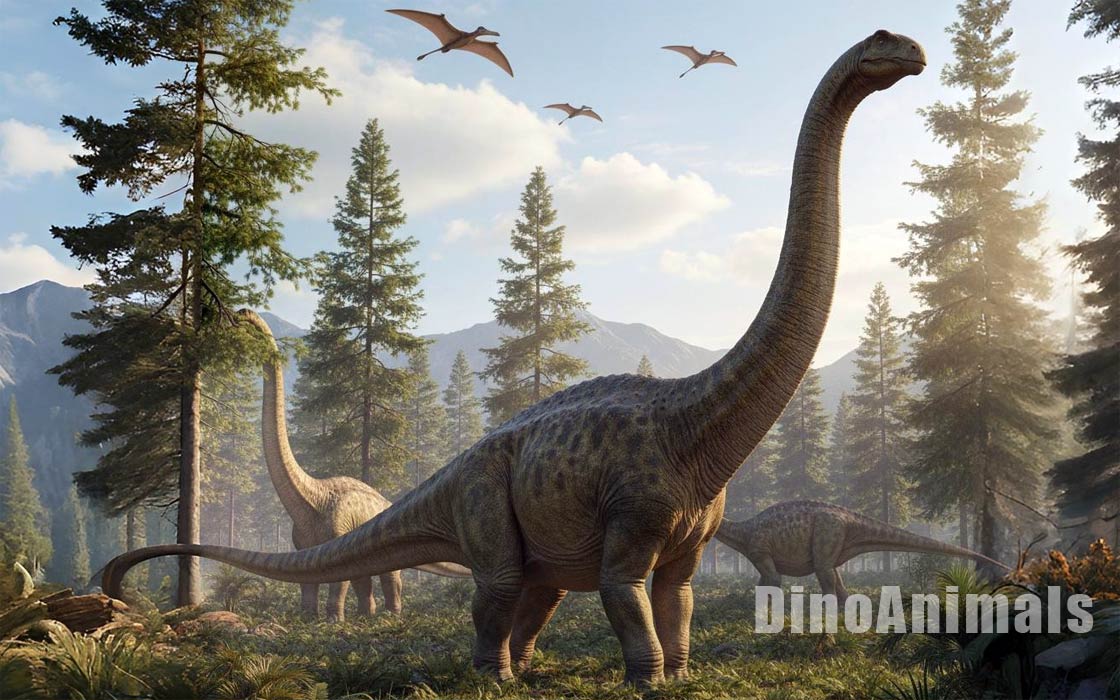Every month, 100,000 readers use the Dinosaur Database, but we receive no support from you. Developing and updating the database requires a lot of work. If you want it to remain open and be updated, please support us via the "Buy us a coffee" button available on every page or via the Support page.
Dinosaur: Alamosaurus sanjuanensis

| Length*: | 27.5 m | 90.2 ft |
| Weight*: | 42 t | 92,594 lb |
*The largest known specimen
Period
Epoch: Late Cretaceous
Stage: Maastrichtian
Years: 70-66 Ma
Details
Status: valid
Author: Gilmore
Year: 1922
Distribution
Area: North America
Country: USA
Region: New Mexico, Texas, Utah
Formation: Ojo Alamo, Kirtland, North Horn, Javelina, El Picacho, Black Peaks
Description
Alamosaurus sanjuanensis
Alamosaurus sanjuanensis was a giant sauropod dinosaur that roamed North America during the Late Cretaceous period, around 70 to 66 million years ago. It is the best-known North American titanosaur, a group of long-necked, plant-eating dinosaurs that were among the largest creatures to ever walk the Earth. The name “Alamosaurus” does not come from the Alamo in Texas, but from the Ojo Alamo Formation in New Mexico, where its fossils were first discovered. Despite its massive size, Alamosaurus managed to survive until the very end of the Cretaceous period, just before the mass extinction that wiped out the non-avian dinosaurs.
Physical Characteristics
Alamosaurus sanjuanensis was a large sauropod, estimated to reach lengths of up to 28 meters (92 ft) long and weigh between 30 and 42 metric tons, 5 meters (16 ft) tall at the shoulder. Its long neck and tail, characteristic of sauropods, were complemented by a relatively small head with spoon-shaped teeth suited for stripping leaves. As a titanosaur, Alamosaurus had a number of unique features, including robust limb bones and possibly some armor-like osteoderms, though the presence of these has not been definitively confirmed for this species. Its limb proportions were unusual compared to other sauropods, with particularly massive forelimbs suggesting a strong, sturdy build. Recent studies of Alamosaurus fossils indicate that it may have grown continuously throughout its life, with some specimens representing juvenile individuals that had not yet reached full size.
Diet and Feeding Habits
As a herbivore, Alamosaurus sanjuanensis primarily fed on a diet of plants, such as conifers, ferns, and flowering plants that dominated the Late Cretaceous landscape. With its long neck, it could reach vegetation high in the trees or sweep across large areas of low-lying plants without needing to move its massive body frequently. Like other sauropods, Alamosaurus did not chew its food but swallowed it whole, relying on its large, barrel-shaped body and possible gastroliths (stomach stones) to help break down tough plant material. Its large size and long neck allowed it to exploit a wide range of vegetation, from ground level up to the tops of trees, giving it access to different food sources throughout the year.
Habitat and Distribution
Alamosaurus sanjuanensis lived in what is now the southwestern United States, with fossils found in New Mexico, Texas, and Utah. During the Late Cretaceous, this region was a warm, semi-arid environment with seasonal rainfall, featuring a mix of floodplains, river channels, and forests. The diverse ecosystem would have supported a range of plant life, providing ample food for large herbivores like Alamosaurus. The presence of Alamosaurus in these areas indicates that it may have been well adapted to a wide variety of habitats, from open plains to wooded areas, and capable of migrating to find new food sources or avoid predators.
Behavior and Social Structure
Like other sauropods, Alamosaurus sanjuanensis likely lived in herds, which would have offered protection from predators like Tyrannosaurus rex, which shared its environment. Fossil trackways suggest that sauropods traveled in groups, and it’s possible that Alamosaurus exhibited similar behavior. Herding would have helped them protect their young, as well as facilitate social interactions and mating. The size and defensive capabilities of an adult Alamosaurus would have made it a formidable opponent for any predator, but younger or injured individuals would have been more vulnerable. The communal nature of sauropods, combined with their size, likely played a key role in their survival strategies.
Discovery and Research
Alamosaurus sanjuanensis was first described in 1922 by paleontologist Charles W. Gilmore, based on fossils discovered in the Ojo Alamo Formation of New Mexico. Initially, the fossils were fragmentary, consisting mainly of vertebrae and limb bones, but subsequent discoveries in Texas and Utah have provided more complete remains. The most significant finds include partial skeletons that have helped paleontologists better understand the size, growth, and anatomy of this giant dinosaur. Despite these discoveries, much of Alamosaurus remains poorly understood, as it is known mostly from disarticulated bones. Ongoing excavations and research are expected to provide further insights into this remarkable dinosaur, potentially clarifying its relationships with other titanosaurs.
Significance and Interesting Facts
Alamosaurus sanjuanensis is significant for several reasons. As one of the last surviving sauropods in North America, it provides valuable insights into the final days of the Age of Dinosaurs, illustrating the diversity and adaptability of titanosaurs. The size and potential growth patterns of Alamosaurus suggest that it may have been among the largest dinosaurs of its time, rivaling or even exceeding the size of more famous giants like Argentinosaurus. Additionally, its survival until the very end of the Cretaceous highlights its resilience in a changing world, filled with diverse predators and fluctuating climates. Recent studies have focused on its bone structure and growth patterns, suggesting that Alamosaurus might have been capable of continuous growth, unlike most other dinosaurs, which reached a fixed adult size.
Locations
Sources
Material: Many individuals (mostly juvenile and subadult).
References: Gilmore, C.W. (1922). "A new sauropod dinosaur from the Ojo Alamo Formation of New Mexico".D'Emic, M. (2012) "The early evolution of titanosauriform sauropod dinosaurs".Lehman, T.M.; Coulson, A.B. (2002). "A juvenile specimen of the sauropod Alamosaurus sanjuanensis from the Upper Cretaceous of Big Bend National Park, Texas".
Lehman, T. M., & Coulson, A. B. (2002). A juvenile specimen of the sauropod dinosaur Alamosaurus sanjuanensis from the Upper Cretaceous of Big Bend National Park, Texas. Journal of Paleontology, 76(1), 156-172.
D'Emic, M. D., & Foreman, B. Z. (2012). The beginning of the sauropod hiatus in North America: Insights from the Lower Cretaceous Cloverly Formation of Wyoming. Journal of Vertebrate Paleontology, 32(5), 1023-1036.




